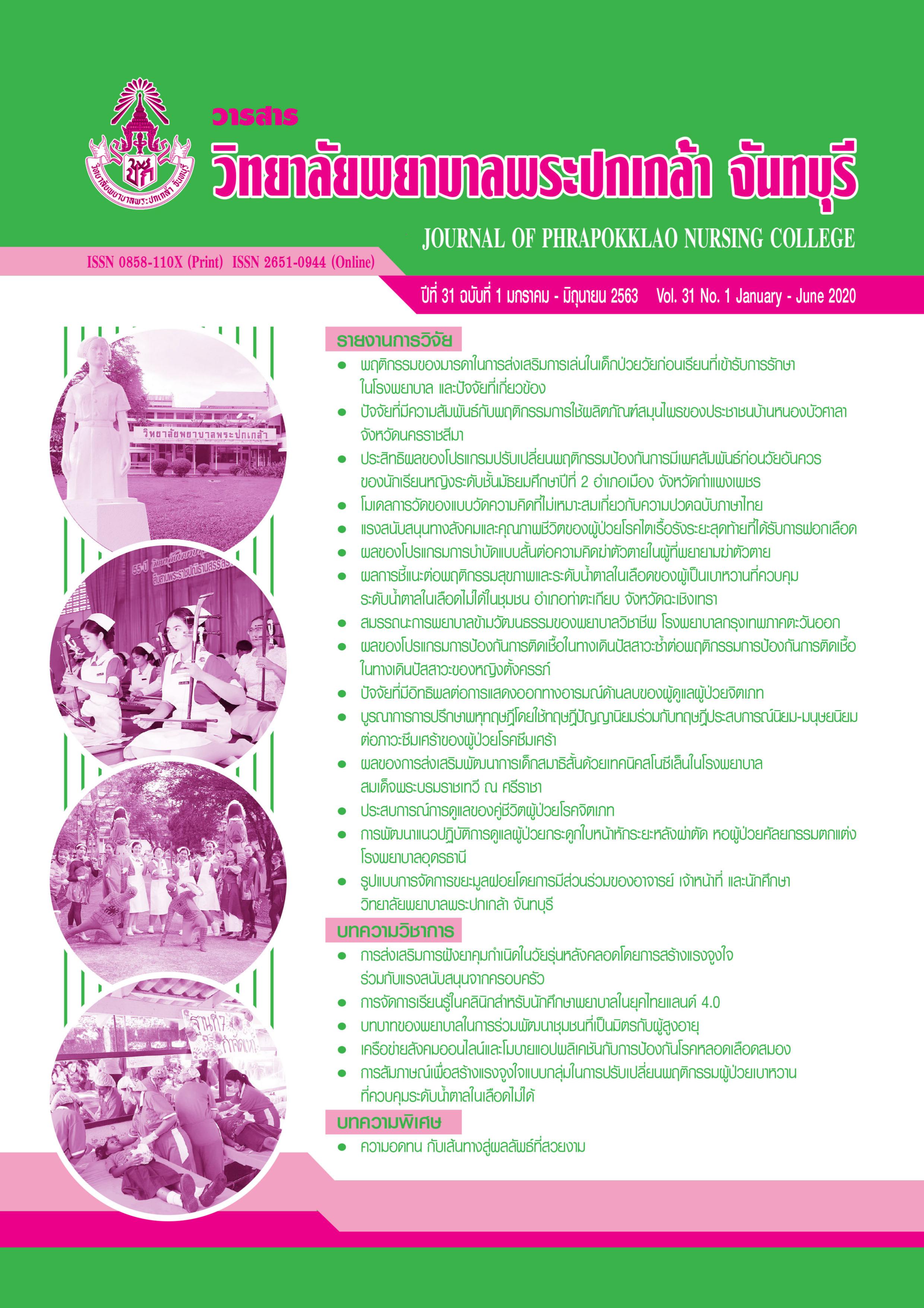Nurse’s Roles for Participation in Age-friendly Community Development
Keywords:
Nurse’s roles, Participation, Development, Age-friendly communityAbstract
Thailand has entered ageing society since 2005 which is rapidly increasing in the elderly. Although, Thailand has worked on the elderly under a National Plan on the Elderly since 2002, there is no identical direction and no integration among the related agencies. Therefore, in 2018, Thailand has driving national agenda regarding ageing society using age-friendly community concepts of WHO for developing the quality of life of the elderly as well as integrative plans among ministries such as the Ministry of Public Health and the Ministry of Interior. For the Ministry of Public Health, the district health promoting hospitals are the local organizations and nurses play a major role in responsibility for health care among the elderly. As we known, health is a basic important component of quality of life development among the elderly according to the concepts of an age-friendly community. Therefore, nurses should understand their roles for participation in age-friendly community development in order to increase an effective collaboration with a multidisciplinary team, community, as well as government and private organizations for age-friendly community development. There are seven nurse’s roles for participation in age-friendly community development as follows: a holistic caregiver, a decision maker, an expert, a responsible friend, a care plan counselor, a team player, and a researcher.
References
กรมกิจการผู้สูงอายุ กระทรวงการพัฒนาสังคมและความมั่นคงของมนุษย์. (2562). มาตรการขับเคลื่อนระเบียบวาระแห่งชาติ เรื่อง สังคมสูงอายุ (ฉบับปรังปรุง). สืบค้นจาก http://www.dop.go.th/download/knowledge/th1539325686-137_0.pdf
กรมกิจการผู้สูงอายุ กระทรวงการพัฒนาสังคมและความมั่นคงของมนุษย์. (2563). เอกสารประกอบการสัมภาษณ์อธิบดีกรมกิจการผู้สูงอายุ เรื่อง การพัฒนาระบบการดูแลสุขภาพที่เหมาะสมกับสังคมผู้สูงอายุ. กรุงเทพฯ: ผู้แต่ง.
ธีระ สินเดชารักษ์, ศุทธิดา ชวนวัน, และคมกฤช ธาราวิวัฒน์. (2556). ผู้สูงอายุในสังคมจีน: การจัดสวัสดิการ ต้นแบบการดูแลและกิจกรรมทางสังคม (รายงานผลการวิจัย). กรุงเทพฯ: มหาวิทยาลัยธรรมศาสตร์.
นภัสชล ฐานะสิทธิ์, อรวรรณ ลิขิตพรสวรรค์, และประภาวดี ตั้งคุณาพันธุ์. (2561). การจัดระบบบริการสุขภาพผู้สูงอายุในชุมชน. ใน เกื้อเกียรติ ประดิษฐ์พรศิลป์, พรทิพย์ ควรคิด, สมบัติ ตรีประเสริฐสุข, ภรเอก มนัสวานิช, ไอศวรรย์ เพชรล่อเหลียน, และไพโรจน์ ฉัตรานุกูลชัย (บ.ก.), ตำราเวชศาสตร์ผู้สูงวัย (น. 979-996). กรุงเทพฯ: รุ่งศิลป์การพิมพ์ (1977).
ปัฐยาวัชร ปรากฎผล. (2560). พยาบาลผู้จัดการรายกรณีโรคเรื้อรัง. วารสารวิทยาลัยพยาบาลพระปกเกล้า จันทบุรี, 28(1), 112-121.
มูลนิธิสถาบันวิจัยและพัฒนาผู้สูงอายุไทย. (2562). สถานการณ์ผู้สูงอายุไทย พ.ศ. 2561. สืบค้นจาก http://www.dop.go.th/download/knowledge/th1573033396-261_0.pdf
วรวรรณ พลิคามิน, ณัฐสุชน อินทราวุธ, พิมพ์ชนก บุนนาค, และวรวิช ลิ้มมณีวิจิตร. (2558). การจัดระบบการดูแลและสิ่งแวดล้อมที่เหมาะสมกับผู้สูงอายุในสังคมสูงวัย. วารสารเศรษฐกิจและสังคม, 52(3), 17-25.
ศศิพัฒน์ ยอดเพชร, เอกจิตรา คำมีศรีสุข, ณัฏฐพัชร สโรบล, และธนิกานต์ ศักดาพร. (2558). การพัฒนาระบบส่งเสริมสุขภาพผู้สูงอายุแบบองค์รวม ในเขตเทศบาลนครนนทบุรี การประเมินผลสัมฤทธิผลศูนย์พัฒนาคุณภาพชีวิตผู้สูงอายุ (รายงานผลการวิจัย). กรุงเทพฯ: มหาวิทยาลัยธรรมศาสตร์.
ศิราณี ศรีหาภาค, โกมาตร จึงเสถียรทรัพย์, และคณิศร เต็งรัง. (2556). ผลกระทบและภาระการดูแลผู้สูงอายุระยะยาวภายใต้วัฒนธรรมไทย (รายงานผลการวิจัย). นนทบุรี: สถาบันวิจัยระบบสาธารณสุข.
สุทธิชัย จิตะพันธ์กุล. (2558). ยุทธศาสตร์การวิจัยและพัฒนากับสังคมผู้สูงอายุสำหรับประเทศไทย. วารสารสถาบันวิทยาศาสตร์และเทคโนโลยีชั้นสูง, 1(1), 80-91.
สุทธิชัย จิตะพันธ์กุล, ขวัญใจ อำนาจสัตย์ซื่อ, นิติกุล ทองน่วม, อรวรรณ์ คูหา, พงางาม พงศ์จตุรวิทย์, และนฤมล ทองมีสิทธิ์. (2556). การศึกษาความพร้อมและความต้องการในการจัดบริการสุขภาพผู้สูงอายุระยะยาวในชุมชน (รายงานผลการวิจัย). นนทบุรี: กระทรวงสาธารณสุข.
Ansari, M. A. (2018). Role of nursing in community health. Journal of Nursing Research and Practice, 2(1), 8.
Arkansas State University. (2017). The role of a professional nurse today. Retrieved from https://degree.astate.edu/articles/nursing/role-of-professional-nurse-today.aspx
Eliopoulos, C. (2014). Gerontological nursing (8th ed.). Philadelphia: Wolters Kluwer Health/Lippincott Williams & Wilkins.
Geller, L. (2015). Age-friendly communities. Retrieved from https://www.canadian-nurse.com/en/articles/issues/2015/january-2015/age-friendly-communities
Handler, S. (2014). An alternative age-friendly handbook. Retrieved from https://www.architecture.com/-/media/GatherContent/Age-Friendly-Handbook/Additional-Documents/AlternativeAgefriendlyHandbook2014pdf.pdf
Role and work of a professional nurse in healthcare and in community. (2019). Retrieved from https://www.careercliff.com/role-work-of-professional-nurse-healthcare-community/
United Nations. (2019). World population ageing 2019: Ten key messages. Retrieved from https://www.un.org/en/development/desa/population/publications/pdf/ageing/WorldPopulationAgeing2019-10KeyMessages.pdf
Walker, A. (2018). How nurses can help create age-friendly communities. Retrieved from https://campaignforaction.org/nurses-can-help-create-age-friendly-communities/
World Health Organization. (2002). Active ageing: A policy framework. Retrieved from https://www.who.int/ageing/publications/active_ageing/en/
World Health Organization. (2007). Global age-friendly cities: A guide. Retrieved from https://www.who.int/ageing/publications/age_friendly_cities_guide/en/
World Health Organization. (2019). Developing age-friendly cities and communities: Case studies from around the world. Retrieved from https://extranet.who.int/agefriendlyworld/resources/age-friendly-case-studies/
Downloads
Published
How to Cite
Issue
Section
License
Copyright (c) 2020 JOURNAL OF PHRAPOKKLAO NURSING COLLEGE

This work is licensed under a Creative Commons Attribution-NonCommercial-NoDerivatives 4.0 International License.
เนื้อความ ข้อมูล และรายการอ้างอิงที่ผู้เขียนใช้ในการเขียนบทความเพื่อลงตีพิมพ์ในวารสารวิทยาลัยพยาบาลพระปกเกล้า จันทบุรี ถือเป็นความคิดเห็นและความรับผิดชอบของผู้เขียน คณะผู้จัดทำวารสารไม่จำเป็นต้องเห็นพ้องด้วยหรือร่วมรับผิดชอบ
บทความที่ได้รับการลงตีพิมพ์ในวารสารวิทยาลัยพยาบาลพระปกเกล้า จันทบุรี ถือเป็นลิขสิทธิ์ของวารสารวิทยาลัยพยาบาลพระปกเกล้า จันทบุรี หากหน่วยงานหรือบุคคลใดต้องการนำส่วนหนึ่งหรือทั้งหมดของบทความไปเผยแพร่ต่อเพื่อวัตถุประสงค์ใด ๆ จะต้องได้รับอนุญาตจากบรรณาธิการวารสารก่อน



